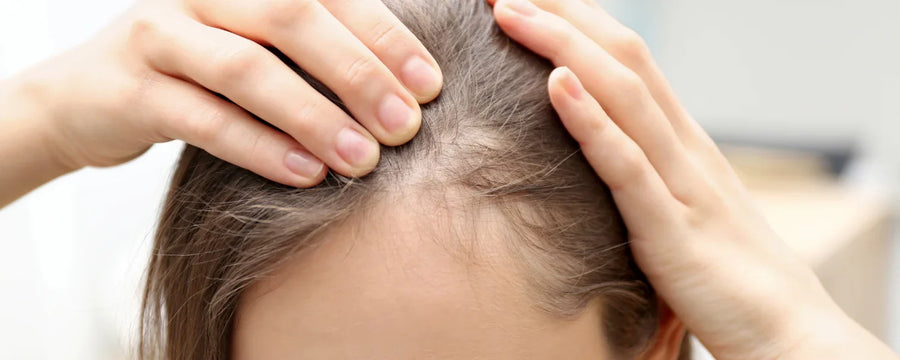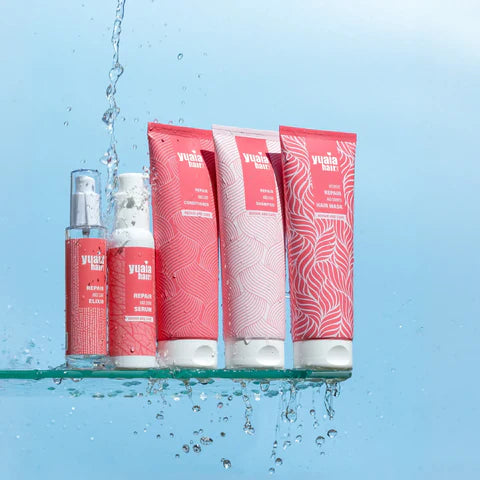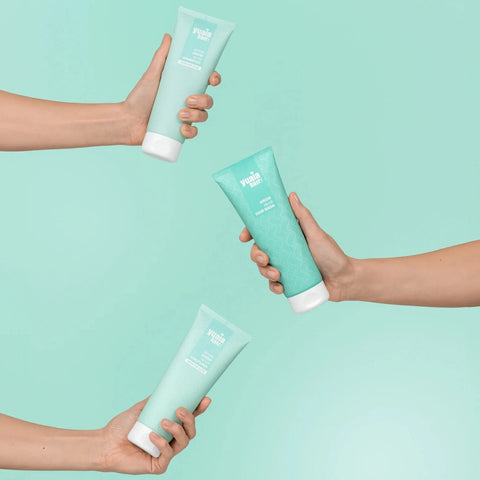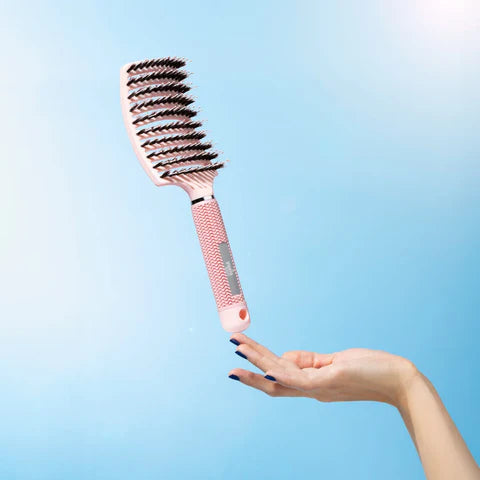
Baby hairs or breakage? How to identify and care for your hairline
by Nitesh Sharma on May 22, 2025

Read through by Dorthe Kristensen
Hairdresser and former co-owner of the award-winning hairdressing chain Zoom by Zoom
With many years of experience in the hairdressing industry, Dorthe has advised many customers about hair and hair care. Dorthe has read through this blog entry to ensure high quality and professionalism. This blog post is professionally updated on May 22, 2025.
Table of contents
It can be frustrating and confusing to look in the mirror and notice short hairs sticking out along your hairline or scattered throughout your scalp.
Are they baby hairs, a sign of healthy new growth, or are they a result of breakage from heat, chemicals, or styling habits? This distinction is important, not just for aesthetics but for long-term hair health.
Understanding the difference allows you to adjust your hair care routine appropriately and protect your strands from unnecessary damage.
What are baby hairs?
Baby hairs are fine, wispy strands found around the perimeter of the hairline. These hairs are naturally shorter than the rest of your hair and often lay flat or curl slightly. While they can sometimes be mistaken for signs of damage, baby hairs are typically part of your natural hair structure and can be either permanent or transitional depending on your hair type and genetics. They tend to grow in a consistent pattern and contribute to a soft, natural look around the face.
What is hair breakage?
Hair breakage occurs when the hair shaft becomes so weakened that it snaps or splits. This can be caused by heat damage, chemical treatments like bleaching, rough handling during detangling, or tight hairstyles that stress the hair shaft.
Unlike baby hairs, broken strands are not naturally occurring; they result from external damage. You can usually identify breakage by its location (anywhere on the scalp), uneven or jagged ends, and a rough, brittle texture.
Is it new growth?
Short hairs along the scalp can often be signs of healthy new growth. These strands typically appear soft to the touch, with tapered ends that distinguish them from breakage. They emerge directly from the scalp in a uniform direction and tend to increase in length gradually, indicating active follicle function. Unlike broken strands, which often feel dry and irregular, new growth usually has a shinier, smoother appearance.
It's common for some to experience a mild tingling or itching sensation on the scalp during early regrowth phases, especially after periods of hair shedding or following the use of stimulating scalp treatments. This sensation may reflect increased blood flow or activity in the follicles, which are positive signs of regeneration.
Paying attention to these indicators can help confirm whether the new strands you're seeing are part of your hair's natural growth cycle rather than signs of damage.
How to tell if baby hairs are breakage or new growth
While baby hairs, breakage, and new growth can all present as short strands, they each have distinct characteristics. Understanding these differences can help guide how you care for them.
-
Baby hairs: Typically found along the hairline, they are soft, fine, and consistent in length. They don’t grow much over time and are often part of your natural hairline pattern.
-
Breakage: Can occur anywhere on the scalp and results in jagged, brittle strands. The hair may feel coarse or dry with split ends. This is often due to mechanical or chemical stress.
-
New growth: Usually starts at the scalp and gradually lengthens over time. It’s softer, has a natural taper, and grows in a consistent direction. It may be more concentrated in areas where shedding previously occurred.
To assess what you're dealing with, consider the following:
-
Are the ends tapered or frayed?
-
Is the texture soft or brittle?
-
Is the growth location-specific (hairline vs random patches)?
-
Do the strands grow longer over time?
These criteria can help clarify whether you’re looking at new hair, damage, or your natural hairline—and guide your next steps.
What do you think the short hairs around your hairline are?
How to care for baby hairs and new growth
Gentle handling for delicate strands
Both baby hairs and new growth are fragile and require a soft, intentional approach to avoid breakage. Lightweight styling products are ideal—they should offer light hold without stiffness or buildup. Avoid over-styling, especially with tight hairstyles or aggressive brushing, which can easily damage these fine strands. Always opt for tools and accessories that minimize pulling or snagging.
Nighttime protection
Reducing friction while sleeping is essential for preserving the integrity of the hairline. Bamboo pillowcases pillowcases reduces surface tension, helping prevent breakage and frizz around the hairline. Protective headscarves or bonnets provide an added layer of defense, especially for those with textured or fragile hair.
Additionally, regularly rotating your hairstyles—avoiding consistently tight ponytails or buns—allows the hairline to rest and recover. This combination of thoughtful fabric choices and low-tension styling helps safeguard delicate strands overnight, supporting healthier, more resilient hair growth over time.
Scalp health and maintenance
A healthy scalp is the foundation for strong, vibrant hair growth. To support optimal follicle function, it’s essential to keep the scalp clean and free of product buildup, which can clog follicles and hinder nutrient absorption. Regular, gentle cleansing with a mild shampoo helps maintain a balanced scalp microbiome without stripping natural oils.
Incorporating soft scalp massages into your routine boosts blood circulation, which enhances the delivery of oxygen and nutrients to the hair roots. This practice can also relieve tension and promote relaxation. Using a nourishing scalp oil or targeted serum further supports the skin and follicles with essential care.
By treating your scalp with attention and care, you create the best possible environment for healthier, more resilient hair over time.
Nourishing products and ingredients
Supporting baby hairs and new growth begins with the right blend of gentle, nutrient-rich products.
Natural oils such as jojoba, castor, and rosemary are especially beneficial. Jojoba oil closely mimics the scalp’s natural sebum, helping to moisturize without clogging follicles. Castor oil is known for its fatty acids and potential to stimulate thicker, stronger strands, while rosemary oil has been linked to improved circulation, which may enhance follicle activity and promote growth.
In addition to oils, choosing a sulfate-free shampoo is important. Sulfates can strip the scalp of its protective oils, leaving it dry and irritated. A gentle, sulfate-free formula helps maintain a balanced scalp environment, allowing follicles to function optimally. For added nourishment, consider conditioners and leave-in treatments with ingredients like aloe vera, biotin, or panthenol, which strengthen fragile strands and lock in hydration. A consistent, ingredient-conscious routine helps baby hairs thrive and supports long-term hair vitality.
Consistency and patience
Hair growth takes time. It may be several months before new strands become visibly longer or blend into your existing hairstyle. With ongoing, thoughtful care, baby hairs and new growth can flourish, ultimately strengthening and enhancing your hairline.
Preventing and repairing hair breakage
If you're dealing with breakage, it’s essential to reevaluate your hair care practices. Limit the use of heat tools and ensure you use a heat protectant when styling. Deep conditioning treatments, protein masks, and hydrating leave-ins can restore strength and elasticity. Avoid tight hairstyles that pull on the roots and switch to gentler alternatives.
Trimming the damaged ends and incorporating strengthening treatments regularly can gradually reduce the impact of breakage. Gentle detangling with a wide-tooth comb and moisturizing products helps preserve your strands.
If you want to know more about treating this effectively, read more about hair breakage here.
Understanding the signs and your hair’s needs
Recognizing the difference between baby hairs, breakage, and new growth is essential for targeted haircare. Breakage may call for restorative treatments, while new growth benefits from protection and nourishment. By identifying each type correctly, you can tailor your routine to support long-term hair health.
This understanding helps you choose the right products, avoid harmful habits, and apply growth-focused techniques more effectively. Gentle handling, consistent care, and observing how your hair responds over time are key. When in doubt, seek professional guidance to create a personalized approach that aligns with your specific hair goals.
Get a 10% discount code sent to you
Receive the best tips and tricks for your hair from Lotte and Nanna 🥰
 2-5 day delivery
2-5 day delivery
 25.000+ satisfied customers
25.000+ satisfied customers
 Satisfaction Guarantee
Satisfaction Guarantee












